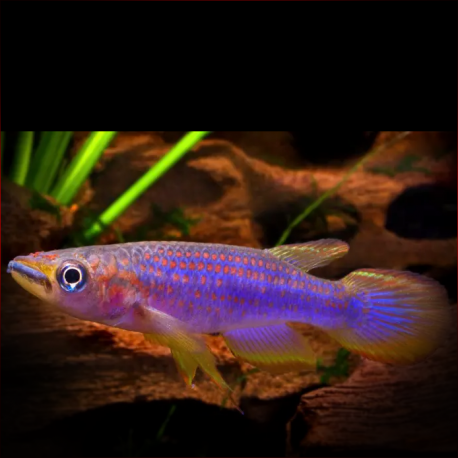More info
Datasheet
| Minimum Tank Size | 96 litres / 25.36 US gallons |
| Maximum Size | 6.0cm / 2.36inches |
| Temperature | 18°C / 64.40°F - 23°C / 73.40°F |
| Hardness | 1.01dgH / 18ppm - 10.03dgH / 179ppm |
| pH | 5.0-7.0 |
General Description
The Red-Spotted Panchax, scientifically known as Epiplatys Lamottei, is a species within the Nothobranchiidae family and falls under the classification order of Cyprinodontiformes. This species can be distinguished by its adult size exceeding 40 mm SL, dark transverse bars with reddish-brown pigmentation on the flanks, and small red spots forming longitudinal bands. Notably, it has a subquadrangular caudal fin, 11-13 anal-fin rays, and 16-17 dorsal-fin rays. Epiplatys is part of the most widely-distributed genus of West African aplocheiloid killifish, primarily found in southeastern Guinea and northern Liberia.
Aquarium Setup
To recreate the ideal habitat for the Red-Spotted Panchax in an aquarium (see table), it is recommended to set up a heavily-planted or natural-style environment with a sandy substrate, driftwood roots, and branches. Adding dried leaf litter not only enhances the natural feel but also provides cover for the fish and supports the growth of microbe colonies. Utilizing aquatic plant species like Microsorum, Taxiphyllum, or Anubias that thrive in dim lighting conditions, along with floating vegetation such as Ceratopteris, is beneficial for these fish.
Behaviour
Red-Spotted Panchax, known for its colorful appearance in male specimens, tends to exhibit territorial behavior, especially during the breeding period. Males are larger and boast more extended fins compared to females. These fish prefer swimming in the upper levels of the water column and are relatively active feeders, especially on live and frozen foods like Artemia nauplii, Daphnia, and small insects.
Feeding and Diet
In their natural habitat, Red-Spotted Panchax likely feed on terrestrial and aquatic invertebrates and zooplankton. When kept in an aquarium, they readily accept dried foods but should also be provided with daily meals of small live and frozen fare such as Artemia nauplii, Daphnia, and grindal worms. Feeding them a variety of foods, including small insects like crickets or Drosophila fruit flies, is essential to ensure their optimal health.
Reproduction & Dimorphism
During the breeding season, male Red-Spotted Panchax intensify their colorful displays to attract females. Males engage in courtship behaviors to entice females for spawning. The sexual dimorphism in this species is evident, with males displaying vibrant colors, extended fins, and larger body size compared to females. Reproduction typically involves the male fertilizing the eggs after the female lays them, leading to the hatching of the offspring.
Habitat and Distribution
Red-Spotted Panchax predominantly inhabit small streams and minor tributaries in regions of southeastern Guinea and northern Liberia, particularly in the upper Niger, upper Lofa, Saint Paul, and Saint John river drainages. These fish are threatened by deforestation and mining activities within their range. The species coexists with other fish species such as E. hildegardae, E. maeseni, and Nimbapanchax viridis in its natural habitat.

